LostInTheWorld
Member
- 108
- 6
- 18
- Location
- Central california
Generally speaking, our wheel rims have popped right out of our tires pretty easily with a little persuasion from a tire iron. Four of our wheels were clean and dry inside when we disassembled them. There is minimal corrosion on the wheels and bead locks. Basically, it all went well and the hardware is in good shape.
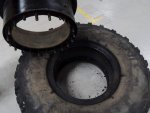
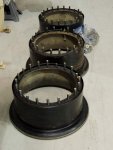
Our fifth wheel is a different story. Our driver side front wheel assembly was visually different from all the others from the beginning. The tire had more tread and was a newer date tire than the rest. All the studs were a little bit rustier, and there was notable RTV on the rim nuts. Also, the inboard wheel half was painted with sand CARC and the others were black.
When we tried to disassemble the fifth wheel, it was very stubborn and did not budge with tire irons and hammering, so we made a debeading tool specifically for that wheel. At 400 ft-lb of torque on the tool, it produced about 31,000 lbs of bead breaking force.
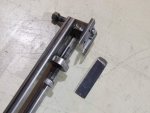
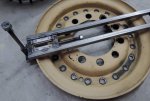
The debeading tool worked pretty well to remove the outboard wheel half. Once we got the outer wheel half off, we noticed several things: RTV was all over the bead and retaining bolts, significant rust on the inboard wheel half flange, and notable moisture / water.
After multiple days of trying to remove the inboard wheel half of the fifth tire, even with the mondo debeading tool, the inner wheel would not come off. We resorted cutting the sidewall of the tire with a jigsaw. A note on cutting the sidewall: it’s super easy. We used one fine tooth metal cutting jigsaw blade (~$1.75) and it only took about 15 minutes. It wrecked the tire, but got the hub out.
What we found in the fifth tire was interesting. The bead lock was completely crushed and crimped around the wheel, and there was about a liter of water in the tire. Evidently when in military service, the tire had gone flat and had somehow crushed the bead lock (??) and accumulated water. We’re not actually sure how that happens, but it evidently did. Just by looking at it, we are 100% sure we did not crush the bead lock during debeading.
An abrasive disc on the grinder freed the bead lock pretty easily. The wheel is a bit rusty so we’ll have to see if it needs replacing. The O-ring seal surface looks fine, but the rest of the wheel looks a little rough right now and we still need to get the bead off of it.
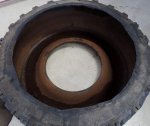
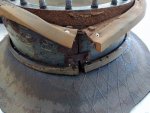
Strangely enough, the tire was not leaking and was one of the better "looking" wheels.
I might be in the market for a new inner wheel half. We will also need a new bead lock.....
Michael


Our fifth wheel is a different story. Our driver side front wheel assembly was visually different from all the others from the beginning. The tire had more tread and was a newer date tire than the rest. All the studs were a little bit rustier, and there was notable RTV on the rim nuts. Also, the inboard wheel half was painted with sand CARC and the others were black.
When we tried to disassemble the fifth wheel, it was very stubborn and did not budge with tire irons and hammering, so we made a debeading tool specifically for that wheel. At 400 ft-lb of torque on the tool, it produced about 31,000 lbs of bead breaking force.


The debeading tool worked pretty well to remove the outboard wheel half. Once we got the outer wheel half off, we noticed several things: RTV was all over the bead and retaining bolts, significant rust on the inboard wheel half flange, and notable moisture / water.
After multiple days of trying to remove the inboard wheel half of the fifth tire, even with the mondo debeading tool, the inner wheel would not come off. We resorted cutting the sidewall of the tire with a jigsaw. A note on cutting the sidewall: it’s super easy. We used one fine tooth metal cutting jigsaw blade (~$1.75) and it only took about 15 minutes. It wrecked the tire, but got the hub out.
What we found in the fifth tire was interesting. The bead lock was completely crushed and crimped around the wheel, and there was about a liter of water in the tire. Evidently when in military service, the tire had gone flat and had somehow crushed the bead lock (??) and accumulated water. We’re not actually sure how that happens, but it evidently did. Just by looking at it, we are 100% sure we did not crush the bead lock during debeading.
An abrasive disc on the grinder freed the bead lock pretty easily. The wheel is a bit rusty so we’ll have to see if it needs replacing. The O-ring seal surface looks fine, but the rest of the wheel looks a little rough right now and we still need to get the bead off of it.


Strangely enough, the tire was not leaking and was one of the better "looking" wheels.
I might be in the market for a new inner wheel half. We will also need a new bead lock.....
Michael
Last edited:


